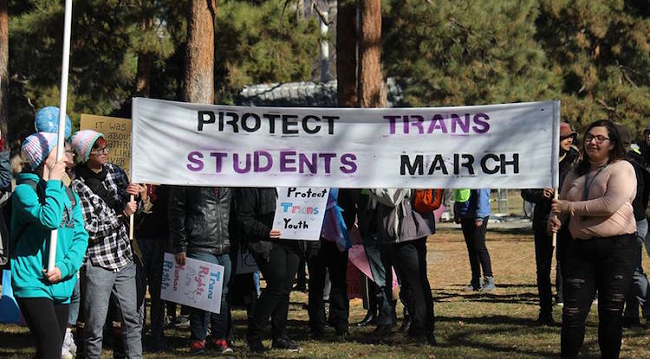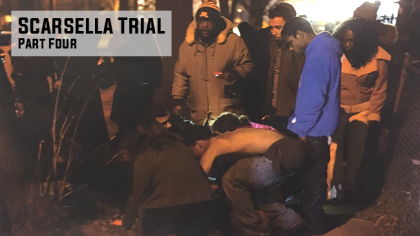Transgender High School Students Organize and Rally for their Rights
Denver, CO – After President Trump’s rescinding of former President Obama’s guidelines for protection of transgender (trans) students in schools on Wednesday, February 22nd, 2017, seven trans high school students in Denver decided to organize a rally and march to oppose the new federal policy on Monday, February 27th, 2017.
This decision does not technically remove trans students’ rights in schools, as it does not change preexisting Title IX, the law that prohibits sex discrimination in federally-funded education. However, by taking away the 2016 “Dear Colleague Letter” (PDF), which explicitly states Title IX includes trans students, the Trump administration has given states and districts more flexibility in how they choose to accommodate, or discriminate, trans students.
The effects of the rescinding are already evident in the U.S. Supreme Court’s rejection on Monday, March 6th, 2017, to hear Gavin Grimm’s case, which was scheduled for later this month on the 28th.
Gloucester High School senior Gavin Grimm, who is represented by the American Civil Liberties Union (ACLU), is suing the Gloucester County School Board for forcing him, a trans man, to use a unisex bathroom after parents complained about his use of the boys’ bathroom.
In accordance with the federal trans student’s rights guidelines–the 2016 “Dear Colleague Letter” (PDF)–the Gloucester County School Board needed to respect and allow Grimm to use the bathroom which was consistent with his gender identity:
Under Title IX, a school must treat students consistent with their gender identity even if their education records or identification documents indicate a different sex. The Departments have resolved Title IX investigations with agreements committing that school staff and contractors will use pronouns and names consistent with a transgender student’s gender identity.”
The school board adopted a discriminatory bathroom policy on December 9th, 2014, which requires trans students to use “alternative private” restroom facilities. The policy was appealed and overturned by the U.S. Court of Appeals for the Fourth Circuit in August 2016, but on Monday that ruling in favor of Grimm was removed by the Supreme Court.
The lawsuit will now go back to the Fourth Circuit to be reheard. However now with the rescinding of the guidelines, the court may find that Grimm’s gender identity, which is male, is not the same as his sex (sex designation assigned at birth), which is female, and therefore his school will be allowed to continue to force Grimm to use the “alternative private” restroom facilities–without the guidelines, Title IX prohibits “sex discrimination,” not “gender identity” discrimination.
Dependent on the court’s ruling, Gloucester High School may also be allowed to refer to Grimm as his sex and name designation assigned at birth, instead of his gender identity and chosen name, setting a scary precedent for trans students across the country.
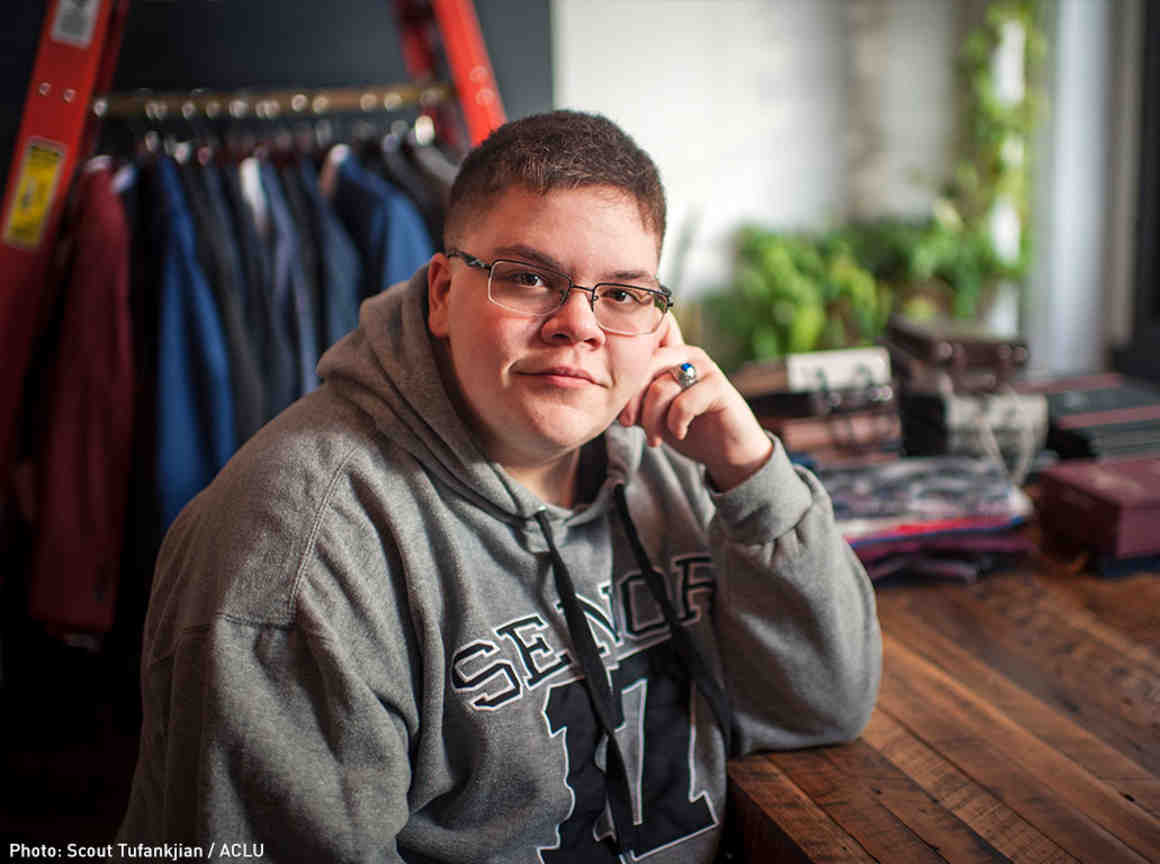
On Thursday morning the 23rd, six of the seven trans students who organized the rally and march, walked out of their high school. One of the students, Lucien, explains why the group decided to walk out:
Everyday in our history class we read this thing called the ‘skimm,’ which just gives a rundown of the events from the day before, and we knew that they were going to be talking about the bathroom policy, and so I got together with my trans buddies and we were like ‘why don’t we just walk out?’ because we know they’re going to talk about it and that’s when they’re going to realize that we’re not there. We wanted to show that we make an impact.”
Earlier Thursday morning before they walked out, the six students hung trans-themed posters up on the walls of their school including ones with statistics like: “You’re more likely to be shot by your dog, than harassed by a trans person in the bathroom.”
Behind the posters they taped note cards which said “You just committed an act of transphobia,” so if anyone took the signs down, they would see the note.
According to Lili, one of the six trans student organizers,
About 10 minutes after we put them up, we had our principal come talk to us because she had seen that note and was personally offended by it. Because as a gay woman who grew up in the ’70s she did not believe she was transphobic. So we were asked to remove all our posters and after that we left.”
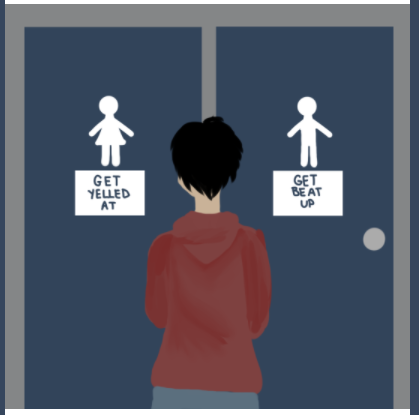
In fact, trans people are the population most at risk of being harassed and attacked in bathrooms. According to a study by the UCLA School of Law (PDF), nearly 70% of trans people said they had experienced verbal harassment in a situation involving gender-segregated bathrooms, while nearly 10% reported physical assault.
Lili went on to share their personal experience with bathrooms:
For me even when I was living in Bayfield, yes, they are in Colorado, yes, I had the right to go in whichever bathroom I felt comfortable in, but they didn’t have a unisex bathroom, like that’s not something schools currently have many of, so I had to decide ‘Alright, male or female? What am I gonna be?’ Then if I went in the male bathroom like ‘Shit, what’s gonna happen to me? There are a ton of huge football players and wrestlers and is it really worth the risk?’ I would just walk ten minutes to get to a bathroom where I knew no one would ever be in and it sucked.”
In 2008, Colorado passed a law that prohibits discrimination on the basis of sexual orientation and gender identity in public places including schools. However, in 31 states, there are no such laws in place, and as Lili points out, even when there are protection laws, they don’t always protect students in the moments they need it.
For Lili and other trans students around the country, they believe more is needed for them to truly feel safe when using the bathroom, locker room, etc., which corresponds to their gender identity.
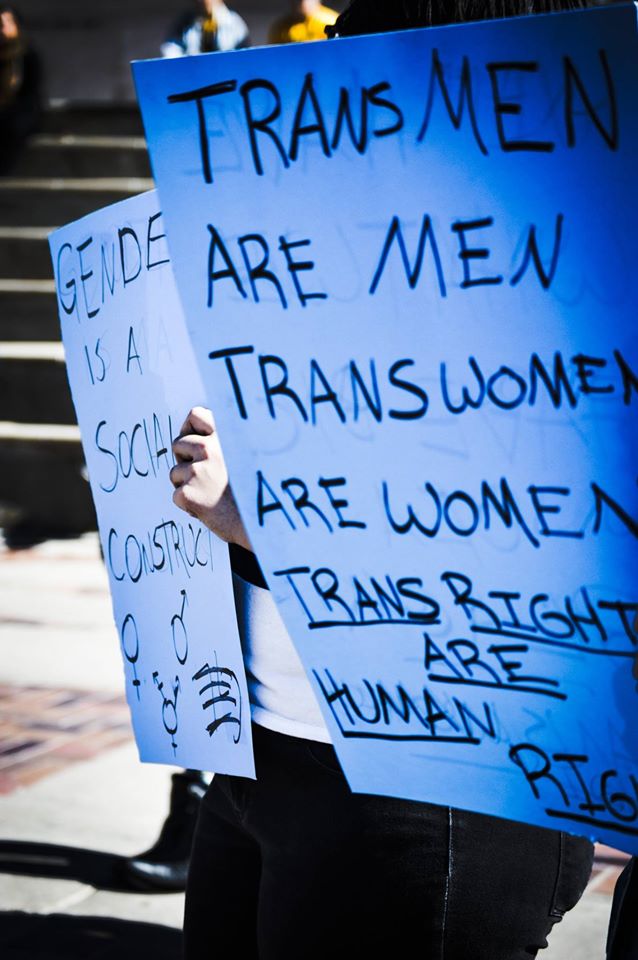
Soon after former President Obama issued the guidelines in 2016, U.S. District Judge Reed O’Connor of Fort Worth, Texas, temporarily blocked the guidelines stating that federal officials didn’t follow proper procedures in creating the directives. Attorney’s representing Texas said the guidelines forced school districts “to mix the sexes in intimate areas.”
The NAACP Legal Defense and Educational Fund, Inc. issued a brief (PDF) concerning the rescinding in which they compare these current discriminatory bathroom polices to those of the recent past:
First, there is a lengthy and troubling history of state actors using public restrooms and similar shared spaces to sow division and instill subordination. Not so long ago, bathrooms nationwide were designated ‘Colored Only’ and ‘Whites Only.’ A key lesson of that painful and ignoble era is that while private-space barriers like racially segregated bathrooms may have seemed to some like minor inconveniences or insignificant sources of embarrassment, they were in fact a source of profound indignity that inflicted deep and indelible harms on individuals of both races, and society at large. This disreputable tradition of state and local governments enshrining fear or hostility toward a disfavored group of people into laws requiring their physical separation from others should encourage this Court to view with skepticism the rationales proffered by local officials here.”
The brief also touches upon the instilled fear of “sexual contact and predation” used to fuel the passage of discriminatory laws:
Misplaced concerns about sexual contact and predation have long been a central dimension of the rationales proffered to justify rules and practices that physically separate people based on class, sex, and race. Today, even in the intimate context of bathing facilities, these rationales and the separations they sought to justify are widely understood to reflect nothing more than discomfort, dislike, and fear, all impermissible bases for government action. . . Speculation and stereotypes about sexual contact and disease were used to justify the racial segregation of bathrooms. A 1957 Arkansas newspaper advertisement entitled, ‘[w]hen you start race-mixing where are you going to stop?’ featured the loaded question ‘[b]ecause of the high venereal disease rate among Negroes [will] white children be forced to use the same rest room and toilet facilities?’ “
The perpetuation of these fabricated fear-based narrations to justify discrimination and subordination are also used to justify the murders of trans people, just as they were and still are used to justify the murders of brown and black people.
According to a comprehensive ongoing report by Mic entitled “Unerased: Counting Transgender Lives,” for young black trans women, 1 in 2,600 are murdered every year in the U.S.; for the general population, it’s 1 in 19,000.
If in 2015 all Americans had the same risk of murder as young black trans women, there would have been 120,087 murders instead of 15,696 murders … From 2010 to 2016, at least 111 transgender and gender-nonconforming Americans were murdered because of their gender identity, 72% of them were black trans women and gender-nonconforming femmes, who identify as neither male nor female but present as feminine. No group under the LGBTQ umbrella faces more violence than transgender people, who accounted for 67% of the hate-related homicides against queer people in 2015, according to the NCAVP.”

In 2016, there were 27 reported murders of trans people in the U.S., marking it the deadliest year for trans people. Experts say these numbers are most likely higher.
Only two months into 2017, there have been a total of seven reported murders of trans people in the U.S., all of which are trans women of color. The three most recent murders occurred in Louisiana and their names are Jaquarrius Holland, Ciara McElveen, and Chyna Gibson. The four other women’s names are Keke Collier, JoJo Striker, Mesha Caldwell, and Jamie Lee Wounded Arrow.
With the continued rising of the hate conjured up through the discriminatory laws and false propaganda, trans people are not only at greater risk of being murdered and harassed, but they are also at greater risk of attempting to commit suicide.
There are so many statistics and one of those famous ones, I guess, about trans people is the 41%, and that 41% represents the percentage of trans people that attempt to commit suicide. It just got me think, you know? I want us to be more than just a statistic. I don’t want people to just see us and see us as suicidal people that aren’t gunna be happy because that’s not true. . . I want the world, to instead of seeing us as a statistic, I want them to see us and see how happy we can be. I want them to see us and see how successful we can be. Because we’re more than just a number. We’re people and we have feelings and we have dreams I want people to know that we’re going to accomplish those dreams, you know?” – Lucien
Other important statistics of trans people, which discriminatory laws and false propaganda aid to, include the pervasiveness of poverty and houselessness in the trans community. In the 2015 U.S. Transgender Survey (USTS) (PDF), the largest survey examining the experiences of transgender people in the United States, with nearly 28,000 respondents from all fifty states,
The findings show large economic disparities between transgender people in the survey and the U.S. population. Nearly one-third (29%) of respondents were living in poverty, compared to 14% in the U.S. population. A major contributor to the high rate of poverty is likely respondents’ 15% unemployment rate—three times higher than the unemployment rate in the U.S. population at the time of the survey (5%).
Respondents were also far less likely to own a home, with only 16% of respondents reporting homeownership, compared to 63% of the U.S. population. Even more concerning, nearly one-third (30%) of respondents have experienced homelessness at some point in their lifetime, and 12% reported experiencing homelessness in the year prior to completing the survey because they were transgender.”
At the “Protect Trans Students March” event in Denver, one trans student summed up why rescinding the trans protection guidelines is “disgusting”:
Children shouldn’t be afraid to be themselves. It shouldn’t be against the law for them to be comfortable in their own body. No longer is this about republicans versus democrats, liberals versus conservatives, right versus left. This is about a violation of basic human rights. What Trump is doing is disgusting, he’s taking away all the progress the transgender community has made in the past couple of years, and it’s not just him. There are so many people who support him [ ]. They think that being transgender is some sort of mental affliction, that something’s wrong with us. But that’s because they don’t understand how it feels to be an intruder in your own body, how it feels to look at yourself in the mirror and not always recognize your reflection, they don’t understand how awful that feels, they’re ignorant to it and that ignorance quickly leads to arrogance. They assume they know what is best and that assumption is hurting people–students–as they force them to be who they are not, but who are they to dictate which bathrooms we use? What name we go by? Or what pronouns we respond to? Why are they so insistent that it somehow affects their lives? They are taking away our right to be ourselves.”
Below is our Part One video of the “Protect Trans Students March” event:
Below is our Part Two video of the “Protect Trans Students March” event:
To help our volunteer-operated horizontally-organized non-profit media collective, please consider a tax-deductible donation:
